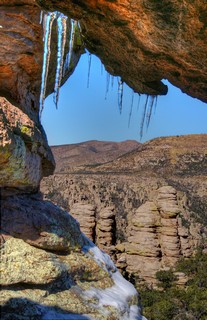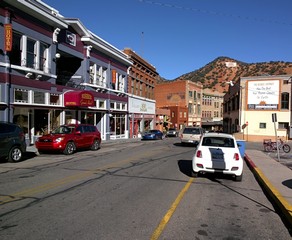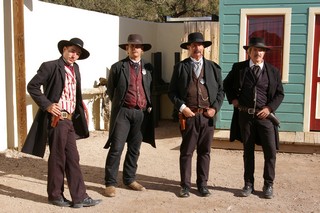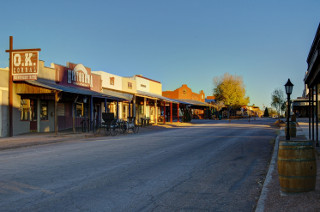South of the Tucson line, the state of Arizona is largely devoid of human habitation and Border Patrol are active in the area: numerous checkpoints and patrolling vehicles are in evidence. Unlike our experience in Texas, I have not been asked for my Green Card; one look at us and we’re waved through. The greatest density of officers we come across is in the Tohono O'odham Nation lands and at a cynical level we wonder whether racial profiling is not as effective a method here.
Chiricahua National Monument is tucked in the southeast corner of the state, located in a small mountain range surrounded by pale desert grasslands. We cross the Chiricahua Mountains on one of Sterling’s shortcuts: unpaved, narrow and rutted. The steady drizzle ensures that the camper is filthy by the time we drive back on to paving and of course I’m to blame, being the driver.
The road loops out
onto the plain where misty rain and failing light make visibility poor. As
we come around to approach the mountains again the mouth of Bonita Canyon,
the entrance into the monument, is obvious even through the haze. The
campground is small, heavily wooded and virtually empty, nudged up against
one side of the canyon. It’s not until the following morning that we catch
our first glimpse of the rocks bathed in the orange light of early
morning.

A concentrated area of distinctive rock formations make this, in Sterling’s words, “The best NPS site you’ve never heard of”: columns, spires, pinnacles and balanced rocks create an intriguing and beautiful landscape, the trails affording both narrow passages amongst the rocks and wide open vistas out of the mountains to the plains below.
 Here on the higher ground the precipitation has fallen as snow, adding another
dimension and accentuating the colours and shapes. The trails are covered
in snow and ice crunching underfoot in the surrounding silence.
It’s a feast for the eyes, a new and different aspect at every turn; ice
crystals glinting in the snow, icicles dripping in the wintry sun,
individual rocks outlined against a rich blue sky, rock formations in
complicated tightly packed mazes, bright green lichen on pinkish rock and
off in the distance pale plains and bare mountain ranges.
Here on the higher ground the precipitation has fallen as snow, adding another
dimension and accentuating the colours and shapes. The trails are covered
in snow and ice crunching underfoot in the surrounding silence.
It’s a feast for the eyes, a new and different aspect at every turn; ice
crystals glinting in the snow, icicles dripping in the wintry sun,
individual rocks outlined against a rich blue sky, rock formations in
complicated tightly packed mazes, bright green lichen on pinkish rock and
off in the distance pale plains and bare mountain ranges.
After weeks of being in places that we’ve previously visited, it’s refreshing to be somewhere both new and so unexpectedly beautiful. We’ll definitely be back, maybe when it’s slightly warmer.
The town of Bisbee is next on
our agenda. It’s a small community with its roots in copper mining but
nowadays is a haven for artists and visitors. At an elevation of over five
and a half thousand feet its climate is tempered into a near perfect year
round temperature. We’re always on the look out for places we might
eventually settle and we’ve come here with that possibility in mind. The
old town itself is in a lovely setting, nestled in among the surrounding
hills but unfortunately in sight of the enormous hole and scarred hills
that are the remains of the mine. As the town has morphed from mining town
 into alternative community of artists, the shops have been turned into
studios and tasteful tourist traps leaving no room for the normal business
of buying food or day to day shopping: all such activity has been
relegated to an area of development some miles down the road. It’s a nice
enough place with a reasonable brew pub but didn’t make it very high on
our list of potential future homes.
into alternative community of artists, the shops have been turned into
studios and tasteful tourist traps leaving no room for the normal business
of buying food or day to day shopping: all such activity has been
relegated to an area of development some miles down the road. It’s a nice
enough place with a reasonable brew pub but didn’t make it very high on
our list of potential future homes.
Bisbee’s not far from Tombstone, and who could resist a visit? In my formative years I watched more black and white westerns than I care to remember and I suspect they might be responsible for the somewhat romanticised view that I still have of such matters.
 The highlight is of course the O.K. Corral. We enter into
the spirit of things and go to the re-enactment of the famous gunfight.
For the uninitiated here are the dramatis personae: Doc Holiday along with
the Earp brothers, Wyatt, Virgil and Morgan facing the Clanton brothers,
the McLaurys and Billy Claiborne. The former group the alleged “goodies”,
the later the “baddies”. As in all good westerns, the goodies live to tell
the tale, albeit with a wound or two while the baddies either get their
comeuppance or run off like the cowards they undoubtedly are. It’s a great
piece of amateur dramatics full of swagger, bravado, threats, counter
threats and of course thirty seconds of sustained gunfire; given the two
sides are only feet away from each other it’s difficult to understand how
anyone is left standing.
The highlight is of course the O.K. Corral. We enter into
the spirit of things and go to the re-enactment of the famous gunfight.
For the uninitiated here are the dramatis personae: Doc Holiday along with
the Earp brothers, Wyatt, Virgil and Morgan facing the Clanton brothers,
the McLaurys and Billy Claiborne. The former group the alleged “goodies”,
the later the “baddies”. As in all good westerns, the goodies live to tell
the tale, albeit with a wound or two while the baddies either get their
comeuppance or run off like the cowards they undoubtedly are. It’s a great
piece of amateur dramatics full of swagger, bravado, threats, counter
threats and of course thirty seconds of sustained gunfire; given the two
sides are only feet away from each other it’s difficult to understand how
anyone is left standing.
The fight took place in 1881 and it is
claimed that the main street in town looks just as it did on that
memorable afternoon when the corral became famous. However authentic, it’s
great fun; the shop fronts and signage belong to a previous era, the
stagecoach is the only vehicle on the dusty road and the boardwalks creak
underfoot as Wyatt keeps an eye on things and Billy Claiborne slouches on
 a bench taking in the sun. The only thing missing is the swinging saloon
doors although we are not disappoint once inside. Big Nose Kate’s, so
named for her nosiness rather than her proboscis, is the most well known
of these. The staff are dressed in costume, the walls covered in
artifacts, pictures and a stained glass facsimile of Kate and another of
Doc who was reportedly her lover.
a bench taking in the sun. The only thing missing is the swinging saloon
doors although we are not disappoint once inside. Big Nose Kate’s, so
named for her nosiness rather than her proboscis, is the most well known
of these. The staff are dressed in costume, the walls covered in
artifacts, pictures and a stained glass facsimile of Kate and another of
Doc who was reportedly her lover.
We both have great fun and while it may not be somewhere for a return visit, I’m especially pleased that we made the slight detour.